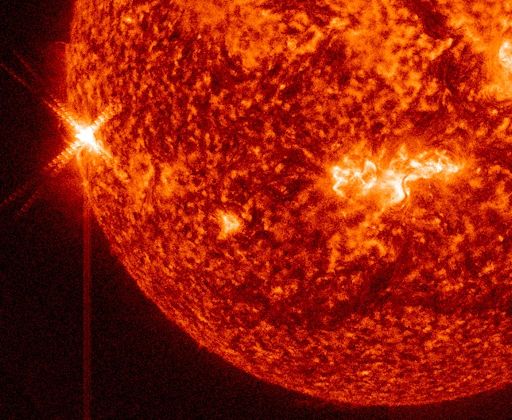X-FLARE UPDATE: Earth-orbiting satellites have just detected a second X-class solar flare on Oct. 25th. The X2-class eruption at 15:07 UT followed an X1-event at 08:01 UT. There is no reason to think this fusillade will end soon, so stay tuned for more flares. Solar Flare alerts: text, voice.
GLOBAL ERUPTION ON OCT 25TH: Solar activity is high and intensifying. New sunspot AR1882, which rotated over the sun's eastern limb earlier today, promptly unleashed an X1-class solar flare, adding to a series of lesser flares already underway from sunspots AR1875 and AR1877. NASA's Solar Dynamics Observatory recorded a bright flash of extreme UV radiation from the X1 flare, which peaked at 08:01 UT on Oct. 25th:
There may be more to this flare than meets the eye. Watch this movie of the sun's entire disk. The X1-flare was bracketed by two erupting magnetic filaments, each located hundreds of thousands of kilometers from AR1882. In other words, the X1 flare might have been just one piece of an interconnected global eruption.
More flares are in the offing. There are now three sunspot groups on the Earthside of the sun capable of strong eruptions: AR1875, AR1877 and AR1882. NOAA forecasters estimate a 55% chance of M-flares and a 10% chance of X-flares during the next 24 hours. Solar flare alerts: text, voice.

Solar wind
speed: 333.6 km/sec
density: 0.8 protons/cm3
explanation | more data
Updated: Today at 1546 UT
X-ray Solar Flares
6-hr max: X1 1500 UT Oct25
24-hr: X1 1500 UT Oct25 Oct24
explanation | more data
Updated: Today at: 1500 UT
![]()
Daily Sun: 25 Oct 13
New sunspot AR1882 is crackling with M- and X-class solar flares. Credit: SDO/HMI
![]()
Sunspot number: 148
What is the sunspot number?
Updated 25 Oct 2013
Spotless Days
Current Stretch: 0 days
2013 total: 0 days (0%)
2012 total: 0 days (0%)
2011 total: 2 days (<1%)
2010 total: 51 days (14%)
2009 total: 260 days (71%)
Since 2004: 821 days
Typical Solar Min: 486 days
Update 25 Oct 2013
The Radio Sun
10.7 cm flux: 161 sfu
explanation | more data
Updated 25 Oct 2013
![]()
Current Auroral Oval:
Switch to: Europe, USA, New Zealand, Antarctica
Credit: NOAA/POES
![]()
Planetary K-index
Now: Kp= 1 quiet
24-hr max: Kp= 1 quiet
explanation | more data
Interplanetary Mag. Field
Btotal: 2.1 nT
Bz: 0.8 nT north
explanation | more data
Updated: Today at 1547 UT
![]()
Coronal Holes: 25 Oct 13
There are no large coronal holes on the Earthside of the sun. Credit: SDO/AIA.





